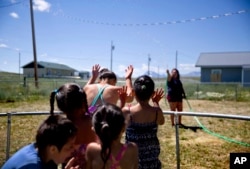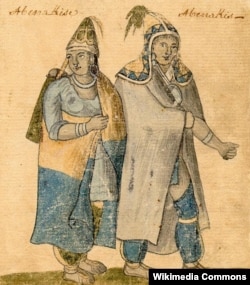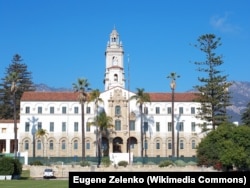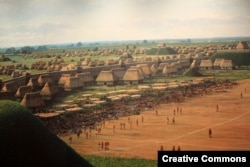Native Americans
Native Americans in Upper Midwest protect their drumming tradition
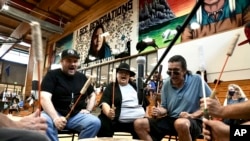
At summertime social powwows and spiritual ceremonies throughout the Upper Midwest, Native Americans are gathering around singers seated at big, resonant drums to dance, celebrate and connect with their ancestral culture.
"I grew up singing my entire life, and I was always taught that dewe'igan is the heartbeat of our people," said Jakob Wilson, 19, using the Ojibwe term for drum that's rooted in the words for heart and sound. "The absolute power and feeling that comes off of the drum and the singers around it is incredible."
Wilson has led the drum group at Hinckley-Finlayson High School. In 2023, Wilson's senior year, they were invited to drum and sing at graduation. But this year, when his younger sister Kaiya graduated, the school board barred them from performing at the ceremony, creating dismay across Native communities far beyond this tiny town where cornfields give way to northern Minnesota's birch and fir forests.
"It kind of shuts us down, makes us step back instead of going forward. It was hurtful," said Lesley Shabaiash. She was participating in the weekly drum and dance session at the Minneapolis American Indian Center a few weeks after attending protests in Hinckley.
"Hopefully this incident doesn't stop us from doing our spiritual things," added the mother of four, who grew up in the Twin Cities but identifies with the Mille Lacs Band of Ojibwe, whose tribal lands abut Hinckley.
In written statements, the school district's superintendent said the decision to ban "all extracurricular groups" from the ceremony, while making other times and places for performance available, was intended to prevent disruptions and avoid "legal risk if members of the community feel the District is endorsing a religious group as part of the graduation ceremony."
But many Native families felt the ban showed how little their culture and spirituality is understood. It also brought back traumatic memories of their being forcibly suppressed, not only at boarding schools like the one the Wilsons' grandmother attended, but more generally from public spaces.
It was not until the late 1970s that the American Indian Religious Freedom Act directed government agencies to make policy changes "to protect and preserve Native American religious cultural rights and practices."
"We had our language, culture and way of life taken away," said Memegwesi Sutherland, who went to high school in Hinckley and teaches the Ojibwe language at the Minneapolis American Indian Center.
The Center's weekly drum and dance sessions help those who "may feel lost inside" without connections to ancestral ways of life find their way back, said Tony Frank, a drum instructor.
"Singing is a door opener to everything else we do," said Frank, who has been a singer for nearly three decades. "The reason we sing is from our heart. Our connection to the drum and songs is all spiritual. You give 100 percent, so the community can feel a piece of us."
In drum circles like those in Minneapolis, where many Natives are Ojibwe and Lakota, there is a lead singer, who starts each song before passing on the beat and verse to others seated at the drum, which is made of wood and animal hide (usually deer or steer).
A drum keeper or carrier cares for the drum, often revered as having its own spirit and considered like a relative and not like personal property. Keepers and singers are usually male; according to one tradition, that's because women can already connect to a second heartbeat when pregnant.
These lifelong positions are often passed down in families. Similarly, traditional lyrics or melodies are learned from older generations, while others are gifted in dreams to medicine men, several singers said. Some songs have no words, only vocables meant to convey feelings or emulate nature.
Songs and drums at the center of social events like powwows are different from those that are crucial instruments in spiritual ceremonies, for example for healing, and that often contain invocations to the Creator, said Anton Treuer, an Ojibwe language and culture professor at Bemidji State University.
Meant to mark the beginning of a new journey in life, the "traveling song" that the drum group wanted to sing at the Hinckley graduation includes the verse "when you no longer can walk, that is when I will carry you," said Jakob Wilson.
That's why it was meant for the entire graduating class of about 70 students, not only the 21 Native seniors, added Kaiya Wilson, who trained as a back-up singer – and why relegating it to just another extracurricular activity hurt so deeply.
"This isn't just for fun, this is our culture," said Tim Taggart, who works at the Meshakwad Community Center – named after a local drum carrier born in the early 20th century – and helped organize the packed powwow held in the school's parking lot after graduation. "To just be culturally accepted, right? That's all everybody wants, just to be accepted."
The school had taken good steps in recent years, like founding the Native American Student Association, and many in the broader Hinckley community turned out to support Native students. So Taggart is optimistic that after this painful setback, bridges will be rebuilt.
And the drum, with all that it signifies about community and a connected way of life, will be brought back.
"Nothing can function without that heartbeat," said Taggart, whose earliest memory of the drum is being held as a toddler at a ceremony. "It's not just hearing the drums, but you're feeling it throughout your entire body, and that just connects you more with the spirit connection, more with God."
As dancers – from toddlers to adults in traditional shawls – circled the floor to the drum's beat in the Minneapolis center's gym, Cheryl Secola, program director for its Culture Language Arts Network, said it was heartwarming to see families bring children week after week, building connections even if they might not have enough resources to travel to the reservations.
On reservations too, many youths aren't being raised in cultural ways like singing, said Isabella Stensrud-Eubanks, 16, a junior and back-up singer on the Hinckley high school drum group.
"It's sad to say, but our culture is slowly dying out," she said, adding that several elders reached out to her and the Wilsons after the graduation controversy to teach them more, so the youth can themselves one day teach their traditions.
Mark Erickson was already about 20 when he went back to Red Lake, his father's band in northern Minnesota, to learn his people's songs.
"It's taken me a lifetime to learn and speak the language, and a lifetime to learn the songs," said Erickson, who only in his late 60s was awarded the distinction of culture carrier for Anishinaabe songs, a term for Ojibwe and other Indigenous groups in the Great Lakes region of Canada and the United States.
Believing that songs and drums are gifts from the Creator, he has been going to drum and dance sessions at the Minneapolis Center for more than a decade to share them, and the notions of honor and respect they carry.
"When you're out there dancing, you tend to forget your day-to-day struggles and get some relief, some joy and happiness," Erickson said.
Native American news roundup July 14-20, 2024

Native Americans discuss impact of a second Trump term on tribal communities
Native Americans were noticeably absent from the Republican National Convention in Milwaukee, Wisconsin, this week. The exception was James Crawford, chairman of the Forest County Potawatomi Community in that state, who opened Day Two of the convention with a speech in which he reminded the audience that events were taking place in lands that were part of the original Potawatomi homelands.
“Our ancestors occupied these lands for hundreds of years, fishing area, rivers and lakes, hunting the land, tapping maple tree groves for sugar and harvesting crops and fields each fall,” Crawford said.
In keeping with Tuesday evening’s theme, “Make America Safe Again,” Crawford addressed threats to Native American safety.
“The growing use and abuse of illegal drugs are claiming countless lives on reservations across this country,” he said, “and Native American women and girls continue to be exploited, trafficked and subjected to violence at reprehensible levels.”
While he did not expressly endorse the Republican ticket, Crawford said he looked forward to working with Republicans to achieve a safe America.
Watch Crawford’s speech below:
Native media’s take on the convention
“Native American Calling,” a radio talk show heard across dozens of public, community and tribal radio stations in the United States and Canada, broadcast live from the event all week, bringing together prominent Native American journalists and business leaders to discuss what a second Donald Trump term might mean for tribal communities.
“Quite clearly, the Republican platform has no mention of Native Americans,” Native News Online editor Levi Rickert noted.
The official platform calls for changes in some federal policies that could impact Native Americans, such as cutting federal funding for any schools pushing “critical race theory (CRT),” an academic concept that racism is built into U.S. legal and government systems, and other “inappropriate racial, sexual or political content.”
The anti-CRT movement has put pressure on many school districts to leave Native American history out of the classroom.
Native American Calling guest panelist Shaun Griswold (Laguna/Zuni/Jemez), editor of Source New Mexico, drew Representative Lauren Boebert into an impromptu interview at the convention in which she stated her desire to head the Interior Department, which manages more than 70% of all federal public lands.
“Public lands are something that are very dear to me,” she said. “ ... and I absolutely care for their [tribal] sovereignty and their prosperity, and that the state and local governments and the federal government is not infringing on your sovereign right."
That said, Boebert said she opposes land grabs by the federal government, such as Joe Biden’s expansion of the Bears Ear National Monument, land sacred to several tribes. See interview, below:
Back to square one
VOA reached out to Shannon O’Loughlin (Choctaw), CEO of the Association on American Indian Affairs (AAIA). She said the last time she saw a Republican platform address Indian Country was in 2016 during Donald Trump's first campaign.
That platform noted that the federal government has not honored its government-to-government relationship with and trust responsibility for tribes.
“It was something that I don't think the Trump administration really ever adopted,” she said.
She expressed concern over Trump’s plans to overhaul civil service by firing thousands of federal employees and replacing them with those loyal to him and the Republican Party.
“This [election cycle] isn't just about presidents,” O’Loughlin said. “It's also about the people who have been working on Native issues within the agencies, sometimes for decades.”
As mandated by the Indian Reorganization Act of 1934, the Interior Department gives preference to Native Americans when hiring for Bureau of Indian Affairs or Indian Health Service jobs.
If these people were to be fired, O’Loughlin worries they would be replaced with people who “have no clue about the basis of federal Indian law, policy and the government-to-government relationship.”
And that would bring groups like the AAIA back to square one.
“It's difficult enough for Native peoples. With every single turnover in the administration and Congress, we have the burden of educating all newly appointed or elected officials,” she said. “We are worried that could change how new Interior Department employees would interpret and oversee many of the statutes under U.S. code.”
Killer of 2 Alaska Native women sentenced to 226 years
A judge in Anchorage, Alaska, this week sentenced a convicted murderer to 226 years in prison for the torture and murder of two Alaska Native women.
Brian Smith was convicted in February of 14 counts, including two counts of first-degree murder, second-degree sexual assault, tampering with physical evidence and misconduct involving a corpse.
As VOA reported in 2019, the victims were Kathleen Jo Henry from the Yupik village of Eek in southwestern Alaska, and Veronica Abouchuk, also Yupik, from the western Alaska village of Stebbins.
The case came to light after Anchorage Police Department homicide detectives were alerted by a woman who found a memory card on the ground labeled “Homicide at midtown Marriott.” The videos revealed that Smith had tortured an unknown woman before killing her, disposing of her body and attempting to hide the evidence.
Read more:
Native American news roundup, July 7-13, 2024

Arizona congressional delegation introduces $5 billion tribal water rights legislation
Arizona's congressional delegation Monday introduced a new bill, The Northeastern Arizona Indian Water Rights Settlement Act of 2024, which would ratify a $5 billion water rights settlement with three Native American nations in the southwestern U.S.
This settlement, the largest of its kind proposed by Congress, seeks to resolve a decadeslong dispute involving the Navajo Nation, the Hopi and the San Juan Southern Paiute tribes.
The agreement, approved by the tribes in May, guarantees them over 56,000 acre-feet of Colorado River water and specific groundwater rights. It also establishes a homeland for the San Juan Southern Paiute Tribe.
Funds from the legislation will be used to develop and maintain water infrastructure, including a $1.75 billion pipeline.
“Ratifying this settlement honors our commitment to the tribes and helps secure our state’s water future, and we’ll work together as Republicans and Democrats to get it done,” Democratic Senator Mark Kelly said in a statement on his website.
San Juan Southern Paiute tribal President Robbin Preston Jr. said the bill, if passed, would change tribe members’ lives.
“With reliable electricity, water and housing, our people will have opportunities that have never been available to us before,” he said in a statement. “This legislation is more than a settlement of water rights; it is the establishment of an exclusive reservation for a tribe that will no longer be forced to live like strangers in our own land.”
Read more:
Tribes, feds plan future of Bears Ears National Monument
Five Native American tribes and the federal government are collaboratively reviewing over 20,000 public comments on the future management of the Bears Ears National Monument in Utah. The public comment period, which ended on June 11, showed wide support for incorporating Traditional Indigenous Knowledge in managing the monument.
The Bears Ears Inter-Tribal Coalition, comprising the Zuni Pueblo, Navajo Nation, Hopi Tribe, Ute Mountain Tribe and Ute Indian Tribe of the Uintah and Ouray, is working with the U.S. Forest Service and the Bureau of Land Management to finalize a co-management plan. This plan, the first of its kind, integrates tribal ancestral history, land conservation and traditional education.
Bears Ears is the most significant archaeological area in the U.S., containing more than 100,000 cultural and archaeological sites.
President Joe Biden restored the Bears Ears monument in October 2021 after the Trump administration significantly reduced its size. In 2023, a federal judge dismissed an attempt by Arizona lawmakers to reverse Biden’s decision. The monument’s designation aims to protect it from future uranium mining and follows the National Park Service's commitment to greater tribal involvement in federal land decisions.
Read more:
Feds expand support for tribal home-visiting programs
The U.S. Administration for Children and Families (ACF), an arm of the U.S. Department of Health and Human Services, has awarded six tribal communities $3 million to expand home-visiting programs for families with young children, part of a larger $30 million investment in the Tribal Maternal, Infant and Early Childhood Home Visiting program.
This funding aims to develop and strengthen tribes’ ability to support and promote the health and well-being of expectant families and families with young children, and prevent children’s placement in foster care.
“We are very excited about this new round of grant recipients, who will develop their programs in collaboration with their communities reflecting their cultures and representing the vision, priorities and hopes they have for future generations,” ACF Principal Deputy Assistant Secretary Jeff Hild said in a statement. “As Tribal home visiting continues to expand, we look forward to engaging with grant recipients and honoring tribal sovereignty as they continue in their journey to provide essential services for young American Indian and Alaska Native children and their families.”
Read more:
Abenaki leaders dispute the legitimacy of unrecognized New Hampshire tribe
The Abenaki community in Quebec has long denounced self-styled Abenaki tribes in Vermont and New Hampshire who operate on claims of Abenaki heritage.
Most recently, a nonprofit called the Ko’asek Traditional Band of the Sovereign Abenaki Nation (KTBSAN) announced plans to build a cultural center in the small New Hampshire city of Claremont on land gifted to them in 2020. In 2023, the city granted their zoning request.
But the KTBSAN is not state or federally recognized, and the Odanak (Abenaki) First Nation in Canada says the New Hampshire group is fake and has no right to speak to Abenaki history and culture.
Historically, Western Abenaki homelands stretched from southeastern Quebec into present-day Vermont, New Hampshire, Maine and north-central Massachusetts. Missionized by French Jesuits in the 17th century, the Abenaki allied themselves with the French in a series of struggles with England over trade. Later, Many Abenaki withdrew to Canada, eventually settling in Saint-François-du-Lac, Quebec.
KTBSAN chief Paul J. Bunnell, a genealogist originally from Massachusetts, told New Hampshire Public Radio that it wasn’t until late in life that he discovered his Abenaki ancestry, information “which we were never told we even had, because it was a taboo subject in most families because we were driven underground because of persecutions.”
Read more:
North Dakota tribe goes back to its roots with a massive greenhouse operation

A Native American tribe in North Dakota will soon grow lettuce in a giant greenhouse complex that when fully completed will be among the country's largest, enabling the tribe to grow much of its own food decades after a federal dam flooded the land where they had cultivated corn, beans and other crops for millennia.
Work is ongoing on the Mandan, Hidatsa and Arikara Nation's 1.3-hectare greenhouse that will make up most of the Native Green Grow operation's initial phase. However, enough of the structure will be completed this summer to start growing leafy greens and other crops such as tomatoes and strawberries.
"We're the first farmers of this land," Tribal Chairman Mark Fox said. "We once were part of an Aboriginal trade center for thousands and thousands of years because we grew crops — corn, beans, squash, watermelons — all these things at massive levels, so all the tribes depended on us greatly as part of the Aboriginal trade system."
The tribe will spend roughly $76 million on the initial phase, which also will include a warehouse and other facilities near the tiny town of Parshall. It plans to add to the growing space in the coming years, eventually totaling about 5.9 hectares, which officials say would make it one of the world's largest facilities of its type.
The tribe's fertile land along the Missouri River was inundated in the mid-1950s when the U.S. Army Corps of Engineers built the Garrison Dam, which created Lake Sakakawea.
Getting fresh produce has long been a challenge in the area of western North Dakota where the tribe is based, on the Fort Berthold Indian Reservation. The rolling, rugged landscape — split by Lake Sakakawea — is a long drive from the state's biggest cities, Bismarck and Fargo.
That isolation makes the greenhouses all the more important, as they will enable the tribe to provide food to the roughly 8,300 people on the Fort Berthold reservation and to reservations elsewhere. The tribe also hopes to stock food banks that serve isolated and impoverished areas in the region, and plans to export its produce.
Initially, the MHA Nation expects to grow nearly 907,000 kilograms of food a year and for that to eventually increase to 5.4 million to 6.4 million kilograms annually. Fox said the operation's first phase will create 30 to 35 jobs.
The effort coincides with a national move to increase food sovereignty among tribes.
Supply chain disruptions during the COVID-19 pandemic led tribes nationwide to use federal coronavirus aid to invest in food systems, including underground greenhouses in South Dakota to feed the local community, said Heather Dawn Thompson, director of the U.S. Department of Agriculture's Office of Tribal Relations. In Oklahoma, multiple tribes are running or building their own meat processing plant, she said.
The USDA promotes its Indigenous Food Sovereignty Initiative, which "really challenges us to think about food and the way we do business at USDA from an Indigenous, tribal lens," Thompson said. Examples include Indigenous seed hubs, foraging videos and guides, cooking videos and a meat processing program for Indigenous animals.
"We have always been a very independent, sovereign people that have been able to hunt, gather, grow and feed ourselves, and forces have intervened over the last century that have disrupted those independent food resources, and it made it very challenging. But the desire and goal has always been there," said Thompson, whose tribal affiliation is Cheyenne River Sioux.
The MHA Nation's greenhouse plans are possible in large part because of access to potable water and natural gas resources.
The natural gas released in North Dakota's Bakken oil field has long been seen by critics as a waste and environmental concern, but Fox said the tribal nation intends to capture and compress that gas to heat and power the greenhouse and process into fertilizer.
Flaring, in which natural gas is burned off from pipes that emerge from the ground, has been a longtime issue in the No. 3 oil-producing state.
North Dakota Pipeline Authority Director Justin Kringstad said that key to capturing the gas is building needed infrastructure, as the MHA Nation intends to do.
"With those operators that are trying to get to that level of zero, it's certainly going to take more infrastructure, more buildout of pipes, processing plants, all of the above to stay on top of this issue," he said.
The Fort Berthold Reservation had nearly 3,000 active wells in April, when oil production totaled 203,000 barrels a day on the reservation. Oil production has helped the MHA Nation build schools, roads, housing and medical facilities, Fox said.
Native American news roundup, June 30-July 6, 2024

Leonard Peltier to remain in Florida prison
The U.S. Parole Commission this week denied parole for American Indian Movement activist Leonard Peltier, who has been incarcerated almost 50 years for the killing of two FBI agents.
Peltier was convicted of two counts of first-degree murder in the deaths of federal agents Jack Coler and Ronald Williams in a June 26, 1975, shooting on the Pine Ridge Indian Reservation in South Dakota. He was sentenced to two consecutive life sentences and has been in prison since 1976.
House Natural Resources Committee ranking member Raul Grijalva, a Democrat from Arizona, expressed his disappointment in the commission's ruling, saying, "The commission had the opportunity to take a small step toward rectifying a decadeslong injustice against Mr. Peltier, but incomprehensibly, they have opted against it."
Federal agents, past and present, hold that Peltier is guilty and shows no remorse for his crime. FBI Director Christopher Wray said in a statement that "justice continues to prevail."
Peltier has an interim hearing about his parole status scheduled for 2026 and a full hearing in 2039.
Read more:
Tribes want a say in Colorado River system water distribution
After a century of being excluded from the discussion, the 30 tribal nations that depend on the Colorado River system are fighting for a greater voice in determining its future when current operating agreements expire in 2026.
The 1922 Colorado River Compact regulated water distribution among seven southwestern states; tribes were not included in those negotiations. Despite holding senior water rights to about a quarter of the river's water, tribes lack access due to funding and legal issues, and this means their water flows downstream to other users.
In April, the Upper Colorado River Commission and six tribes with land in the Upper Basin signed a memorandum of understanding, agreeing to meet about every two months to discuss issues. Still, it does not give tribes a permanent seat on the commission, nor does it give them any authority to make decisions.
Read more:
California Franciscans: Extend deadline for clergy abuse claims for tribes we failed to notify
The Franciscan Province of St. Barbara is asking a bankruptcy court to extend the July 19 deadline for clergy sex abuse claims after a National Catholic Reporter, or NCR, investigation revealed that claim notices had not been sent to seven Native American tribes and communities in Arizona and New Mexico where abusive friars were known to serve.
The St. Barbara Franciscans filed for bankruptcy in late December 2023 in the face of dozens of new allegations of clergy sexual abuse.
A judge on May 22 ordered the St. Barbara Province to mail out "Sexual Abuse Claim Notice Packages" to eight state attorneys general, sheriffs’ offices and other agencies, and 27 newspapers, most of them in California.
The NCR compared the order with a list of "credibly accused" friars the St. Barbara Franciscans maintain on their website, noting that they had failed to send notices to the Colorado River Indian Tribes, Gila River Indian Community, Pascua Yaqui Tribe, San Carlos Apache Tribe, Tohono O'odham Nation and White Mountain Apache Tribe in Arizona, and the Mescalero Apache Tribe in New Mexico.
The Franciscans subsequently asked for the deadline to be extended to August 30 and notified the tribes.
BishopAccountability.org, which tracks clergy abuse cases, reports that 32 U.S. Catholic dioceses and three religious orders have filed for bankruptcy protection in the face of sex abuse accusations.
Read more:
North Carolina housing development is site of significant Native American village
A political fight is underway in North Carolina over what the state archaeologist has called one of the most significant finds ever uncovered — thousands of artifacts and evidence suggesting the presence of a Native American village occupied for centuries before European contact.
The discovery was made on a building site in Carteret County, where developers have already begun building housing.
The North Carolina Office of State Archaeology recommended exploration due to previous discoveries in the area from the 1970s. Construction halted as they dug 16 trenches across more than an acre, uncovering over 2,000 artifacts, including 11 potential human burial sites, 1,700 building post molds, 206 small pits, 45 large pits, 34 pits containing shells and more.
The developers' design engineer, however, dismissed the findings as a "Native American landfill" containing "nothing significant."
State Senator Michael Lazzara agrees and is pushing a bill that allows development to move forward.
Read more:
New theory emerges on Cahokia abandonment
Hundreds of years before Europeans arrived in the Western Hemisphere, Cahokia was the largest North American city north of Mexico and one of the biggest communities in the world.
Founded around 1050 by the Mississippian culture, Cahokia sat on the banks of the Mississippi River near present-day St. Louis, Missouri. At its height, Cahokia had a population of 50,000 but was deserted by 1400 CE. While scientists traditionally blamed drought and crop failure for its abandonment, a new study suggests otherwise.
Washington University researchers Natalie Mueller and Caitlin Rankin found no radical change in plant types.
"We saw no evidence that prairie grasses were taking over, which we would expect in a scenario where widespread crop failure was occurring," Mueller said.
Mueller believes the abandonment was gradual.
"I don't envision a scene where thousands of people were suddenly streaming out of town," she said. "People probably just spread out to be near kin or to find different opportunities."
Read more:









